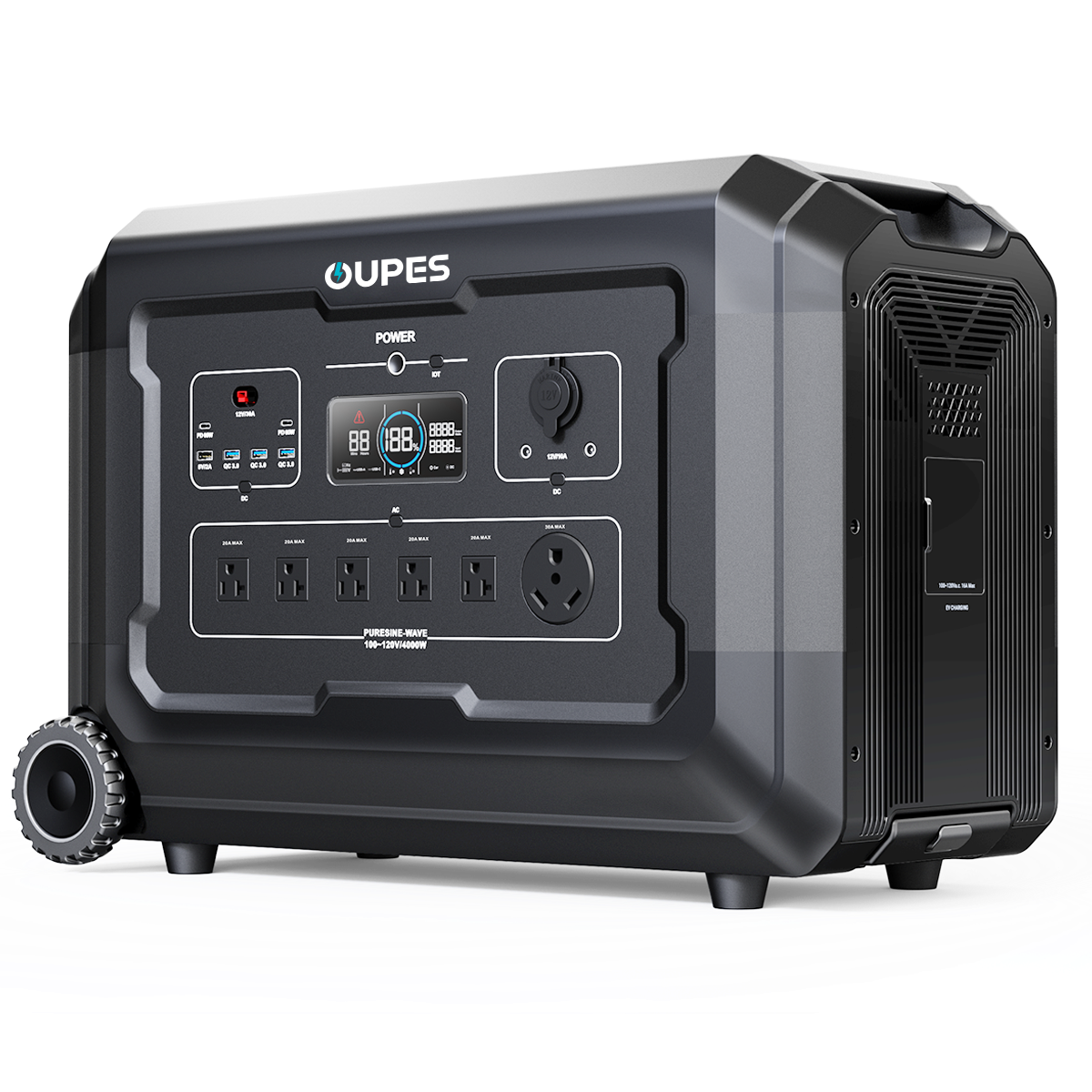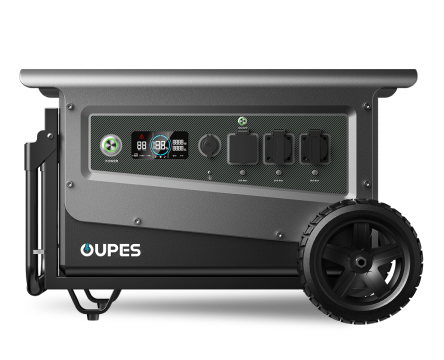
Why Portable Solar Generators Matter in Hurricane Season
When hurricanes strike, prolonged grid outages are common. Fuel supplies can be disrupted, roads blocked, and gas stations offline. Portable solar power generators—also called portable power stations paired with solar panels—offer quiet, emission-free electricity that doesn't rely on fuel deliveries. They're safe to use indoors for charging devices, running communications equipment, and keeping critical low-to-moderate-power appliances operational.
Benefits in a Disaster Context
- Fuel independence: Sunlight replaces gasoline or propane, reducing logistical risk.
- Indoor safety: Battery systems have no exhaust fumes; no carbon-monoxide hazards.
- Low maintenance: No oil changes or carburetors; simple to store and deploy.
- Scalable: Add panels to improve daily recovery and extend runtime.
How a Solar Generator Works (Quick Refresher)
A solar generator system combines:
- Solar panels to capture sunlight and produce DC power.
- An MPPT charge controller (usually built-in) to optimize charging.
- A lithium battery (often LiFePO₄) to store energy safely.
- A pure sine wave inverter to power household AC devices.
Many modern stations also provide USB-A/USB-C PD fast charging and regulated 12 V DC outputs for efficient direct-DC use (less conversion loss).
Selection Criteria: What "Best" Really Means
The "best" portable solar generator for hurricane season balances three pillars: capacity (kWh), output (kW), and solar input (W). Beyond raw power, build quality, battery chemistry, weather-savvy accessories, and ease of use matter.
Core Criteria
- Battery capacity (Wh/kWh): Determines how long you can run essentials between recharges.
- Inverter output: Continuous watts (for running) and surge watts (for starting motors).
- PV input (W and voltage range): How fast you can recharge via solar each day.
- Battery chemistry: LiFePO₄ is favored for safety, long cycle life, and thermal stability.
- Port mix: AC outlets, USB-C PD (e.g., 100 W), multiple USB-A, regulated 12 V.
- Build & weather readiness: Rugged handles, cable management, protected ports, and panel tie-downs.
- Smart monitoring: App control (Wi-Fi/Bluetooth) helps track loads and charging windows.
OUPES portable power stations (e.g., Mega series) are examples of systems designed with LiFePO₄ cells, robust port selection, and app monitoring. We'll keep all guidance brand-agnostic while noting where such features help.
Sizing Guide: Capacity, Output & Solar Input
Start by listing critical loads. For hurricane use, common priorities are:
- Phones/routers/radios (10–50 W)
- LED lighting (5–15 W per lamp)
- CPAP/medical devices (30–120 W, model dependent)
- Refrigerator (~60–150 W running; higher surge to start)
- Laptop/tablet (30–100 W while charging)
- Small fans (20–60 W)
Step-by-Step Sizing
- Sum your simultaneous power (W): e.g., fridge 120 W + router 15 W + two LED lamps 20 W + phone/laptop 50 W ≈ 205 W running. Ensure inverter continuous rating comfortably exceeds this (add headroom; target ≥500–1,000 W for flexibility).
- Estimate daily energy (Wh): 205 W × 10 h/day (conservative planning window) ≈ 2,050 Wh/day.
- Choose capacity: For 2–3 days of autonomy without solar, aim for 4–6 kWh. With solar recharging, you can downsize capacity and rely on daily harvest.
- Match solar input: To recover ~2 kWh/day, plan ~400–800 W of panels depending on sun hours and shading.
Runtime Examples: What You Can Expect
Use the rule of thumb: Runtime (hours) ≈ Battery (Wh) × 0.85 ÷ Load (W) (0.85 accounts for inverter and system losses; real-world varies).
| Battery Size | Example Load | Estimated Runtime | Notes |
|---|---|---|---|
| 1,000 Wh | Phone/router (30 W) + LED lamp (10 W) = 40 W | ≈ 21 h | Great for comms & lights; not for fridge overnight |
| 2,000 Wh | Fridge (120 W avg) + router (15 W) + lamps (20 W) = 155 W | ≈ 11 h | Pairs well with daytime solar to stretch runtime |
| 3,000 Wh | Fridge (120 W) + laptop/phones (60 W) + fans/lights (50 W) = 230 W | ≈ 11 h | Covers one full day with conservative use + solar |
| 5,000 Wh | Same 230 W scenario | ≈ 18.5 h | Robust 24-hour coverage; solar tops up daily |
About Refrigerators & Surges
Most modern fridges cycle on/off. The average draw over hours can be 60–150 W, but startup surges may hit 600–1,000 W momentarily. Ensure your inverter's surge rating safely covers this.
Solar Panel Planning for Cloudy, Post-Storm Days
Hurricanes often bring days of cloud cover. You can still harvest energy, but plan conservatively.
Panel Sizing Tips
- Target daily harvest: If you need ≈2 kWh/day, and expect 3–4 "usable" sun hours after storms, plan 600–800 W of panels (2 kWh ÷ 3–4 h ≈ 500–670 W; add margin).
- Portable vs foldable panels: Foldables are quick to deploy and store; rigid panels are more efficient per dollar but heavier to handle.
- Angle & placement: Keep panels clear of debris, avoid shading, and angle toward the sun (even a small tilt helps water run off).
- Cabling & safety: Use proper MC4 extensions; keep connections off wet ground; secure panels against gusts.
Feature Checklist for Hurricanes
When evaluating "best" options for the season, look for:
High-Value Features
- LiFePO₄ battery: Safer chemistry, long cycle life (often 3,000–6,000+ cycles to 80%).
- Pure sine wave inverter: Clean power for sensitive electronics and motors.
- Ample AC + DC + USB-C PD: Versatile ports reduce adapters and conversion loss.
- Strong PV input + MPPT: Faster, more efficient solar charging.
- Smart app: Monitor state-of-charge, input/output, and estimate runtime at a glance.
- Rugged build: Solid handles, corner protection, and covered ports.
- UPS/backup mode (if offered): Seamless transition for critical electronics.
OUPES systems emphasize LiFePO₄ batteries, robust port arrays, and Wi-Fi/Bluetooth app control—features that map well to hurricane resilience without relying on fuel logistics.
Comparison Table: Good / Better / Best Tiers
Not all needs are the same. Use this table to align budget and readiness level.
| Tier | Battery Capacity | Inverter Output | PV Input | Best For | Pros | Trade-offs |
|---|---|---|---|---|---|---|
| Good | 1–2 kWh | 600–1,000 W | 200–400 W | Comms, lights, small devices | Lightweight, affordable, simple | Limited fridge runtime; careful load management needed |
| Better | 2–3 kWh | 1,000–2,000 W | 400–800 W | Fridge + comms + lights + fans | Balanced capability; viable daily solar recovery | Heavier; still must manage high-surge appliances |
| Best | 4–6 kWh+ | 2,000–3,000 W+ | 800–1,600 W+ | Extended outages; multiple rooms or devices | Comfortable 24-hr coverage; robust surges | Higher upfront cost; larger footprint |
72-Hour Deployment Plan (Step-by-Step)
A clear plan turns good gear into dependable resilience.
T-48 to T-24 Hours (Before Landfall)
- Charge the station to 100%; test outlets and cables.
- Stage panels, MC4 leads, and stakes/weights indoors for quick deployment.
- Pre-cool the refrigerator and freezer; freeze water bottles to act as cold sinks.
- Download/verify the app; label critical loads (router, fridge, lamp, CPAP).
During the Storm
- Keep the power station high and dry, away from windows/doors.
- Use LED lighting and DC/USB-C where possible to conserve energy.
- Avoid opening the fridge unless necessary; cycle loads if needed.
Post-Storm: Daylight Recovery
- Deploy panels safely after winds subside; clear debris and shade.
- Log input watts in the app and track daily harvest vs. consumption.
- Rotate device charging in windows of peak sun (late morning to mid-afternoon).
Care, Storage & Battery Health
Hurricane readiness is a year-round commitment.
Best Practices
- Store at moderate temperature; avoid extreme heat or freezing.
- If unused for months, maintain ~40–60% state-of-charge and top up every 3–6 months.
- Keep cables organized and labeled; inspect connectors periodically.
- Clean panels with soft water and a non-abrasive cloth; inspect for micro-cracks after storms.
Myths vs. Facts
| Myth | Fact |
|---|---|
| "Solar generators are useless in cloudy weather." | Panels still produce power under clouds—less than peak, but enough to extend runtime when managed wisely. |
| "Batteries can't run refrigerators." | A properly sized inverter and battery can run most modern fridges; plan for startup surge and average duty cycle. |
| "You must go huge or it's not worth it." | Even 1–2 kWh improves safety: communication, light, charging, medical devices. Scale as budget allows. |
| "Gas is always more reliable." | Fuel access can fail after hurricanes. Solar offers silent, safe, and independent replenishment. |
FAQ
1) How big of a portable solar generator do I need for hurricanes?
List your simultaneous loads and daily energy need. Many households target 2–3 kWh with 400–800 W of solar for essentials; larger homes or longer outages may choose 4–6 kWh+.
2) Can a solar generator power a full-size refrigerator?
Yes, if the inverter's continuous and surge ratings are sufficient. Typical fridges average 60–150 W with higher startup surges—confirm your model's label and allow headroom.
3) What about medical devices like CPAP?
Many CPAPs draw 30–80 W (without heated humidifier). Use the device's DC adapter if available (more efficient than AC) and confirm runtime with your station's app.
4) Is LiFePO₄ worth it?
For hurricane readiness, LiFePO₄ offers excellent thermal stability, long cycle life, and consistent performance—making it ideal for repeated seasonal use.
5) How does OUPES fit into this?
OUPES focuses on LiFePO₄-based portable power stations with robust port options, app monitoring (Wi-Fi/Bluetooth), and strong PV input—features aligned with hurricane resilience. Choose a capacity and panel kit that fits your load plan and budget.
6) Can I leave the station plugged in as a UPS?
If your model supports UPS/backup mode, yes—verify transfer time and watt limits for critical devices like routers, modems, and small electronics.
7) Do I need special permits for portable panels?
Portable/foldable kits typically don't require permits. For permanent rooftop systems, consult local code. In hurricane zones, secure mounting is essential.
Final Thoughts
The "best" portable solar power generator for hurricane season is the one that's correctly sized, charged, and ready before you need it. Prioritize LiFePO₄ safety, sufficient inverter capacity, generous PV input, and clear deployment steps. With smart planning—and a well-chosen system such as an OUPES portable power station—your household can maintain light, communication, refrigeration, and peace of mind when the grid goes dark.




























